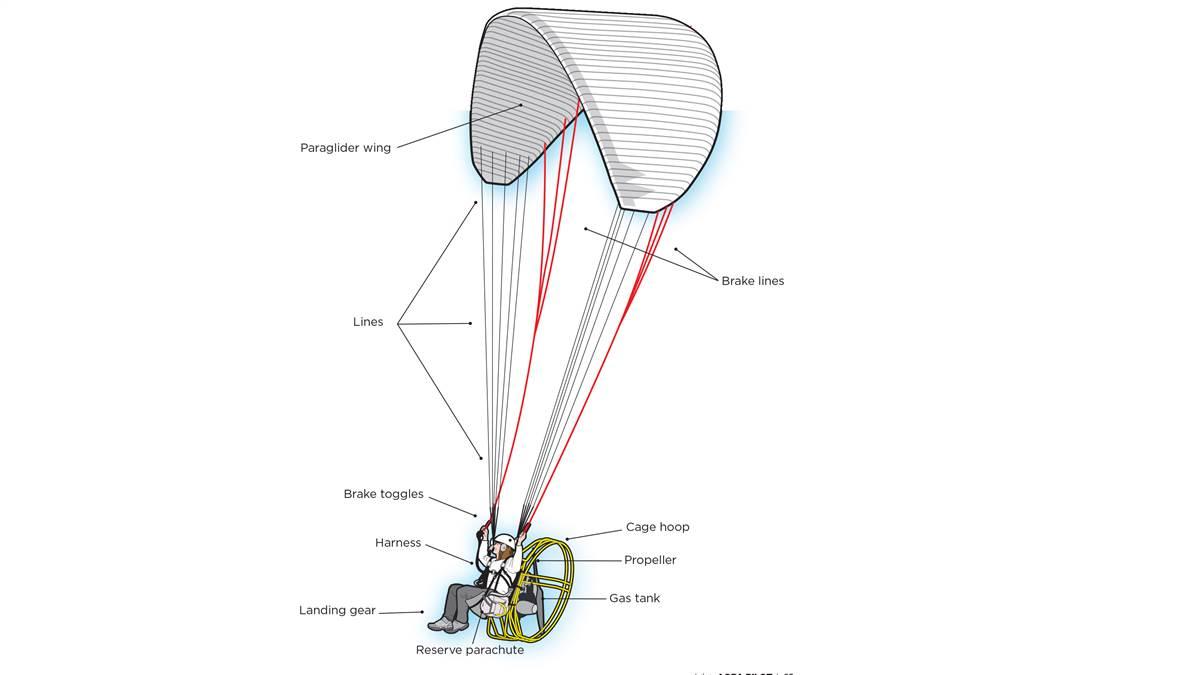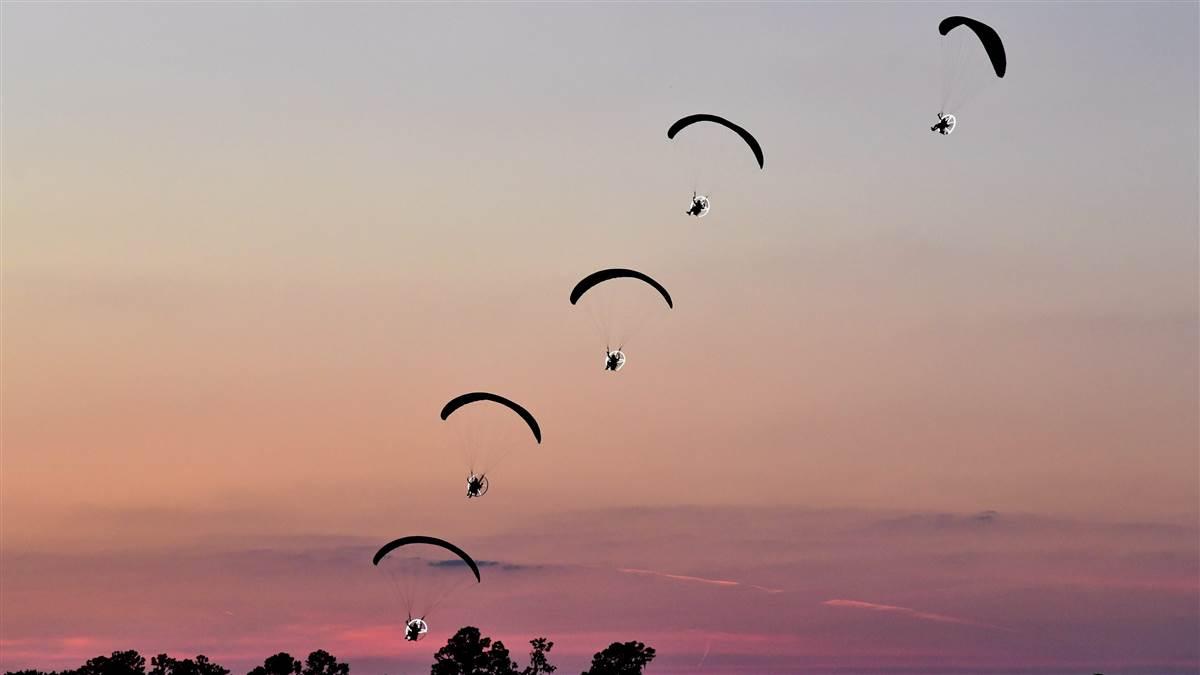Running free
Learning to fly powered paragliders
By Jared Yates
When my wife and I signed up for powered paraglider training, our fixed-wing flying friends asked, “Why would you want to fly those things?” The short answer is “because it’s fun!”
Powered paragliders are foot-launched inflatable wings, powered by a backpack motor with propeller. Flying early in the morning or late in the evening when the winds die down and the sun angles are low, powered paraglider pilots run a few steps and are lifted into a sky that is often painted with a rainbow of colors. They sit back into a harness that is made to be a chair, and enjoy an immersive panoramic sensory experience of sights, sounds, and smells. With a little practice, motorized fliers are able to launch from spaces as small as a soccer field, and swoop along freely from the level of the treetops on up.
Also called “paramotors,” powered paragliders operate under the ultralight rules of Part 103. Here, the limitations and privileges are based on protecting the nonparticipating public, so there are restrictions on aircraft weight, top speed, stall speed, and fuel capacity. No passengers are allowed, and pilots are prohibited from flying over congested areas, assemblies of people, and from operating in a way that is hazardous to others. In return for these limitations, pilots are not required to have any formal training.
In this regulatory vacuum, training choices range from reading books and watching YouTube videos to a structured program such as the one we selected at Aviator PPG in Lake Wales, Florida. We liked that we’d be able to train on school-owned equipment, and pay for training separately from purchasing our own gear. Powered paragliders generally are not available to rent. Some instructors do not charge for training, but they expect students to buy the equipment that they sell, setting up a potential conflict of interest when it comes to advice on what gear is best.
Aviator started in 2012 and is a partnership between experienced paraglider pilots Eric Farewell and Travis Burns—these names might be familiar to folks who have seen the Paradigm Aerobatic Team perform at airshows (see “Shifting the Paradigm,” p. 67). Currently the wait list for training stretches more than two years, and Aviator has begun developing a network of “alliance schools” around the country to help meet the demand.
We reserved two of the six training spots for a September 2017 class. Aviator requires that students attend as a group for at least the first seven days of class; most students train for 12 to 15 days.
To start what would add up to about 20 hours of ground school, we learned the basic anatomy of the wing, also called the glider; how to attach it to the harness; and how to “kite” the wing—that is, inflate it without the intention of flying.
Powered paragliders fly under wings that are very similar—and in some cases, identical—to the wings used by “free flyers” who launch from hills and fly without motors. The motor is clipped to the wing by two carabiners, and the rig’s flying characteristics are determined primarily by the design of the wing. Beginner wings fly like a Cessna 172, expert wings fly like an Extra 300, and there are many levels in between. Since the wings all fly on the same motor, an experienced pilot can choose a flying machine based on which wing he or she clips on for that flight.
By the afternoon of the first day, we were running around in the grass having a great time, learning and sweating as we practiced kiting. The next day brought a new layer of skills as we learned about operating the motor—a two-stroke, air-cooled, single-cylinder engine displacing 190 cubic centimeters and producing around 165 pounds of thrust. Once the motor unit is on the pilot’s back, the four-foot propeller represents minimal risk to the pilot. But when the engine is running, the prop requires constant vigilance to avoid damage to other people, property, or the equipment.
The first training exercise was in a “simulator,” where the motor hangs from a contraption that looks like a giant swing set, attached by the same hang points it would use in flight. The instructors use radio communications to guide students through the first flight, allowing them to learn the response of the throttle and the feeling and sound of the running motor.
Next, we did thrust/posture exercises, where we strapped on the motor and walked around with it running. Once the motor starts producing thrust, the pilot can lean back against that thrust. The empty weight of the motor and harness is a little more than 40 pounds, and we were typically operating with the three-gallon fuel tank half full. Even though these are some of the lightest motor units available, the weight was noticeable, and these exercises helped us get used to the weight and vibration without the distraction of a wing overhead.
Much of the second day’s ground school was spent briefing the upcoming flights. Since the first flight is solo, the instructor issues directions by radio. As training progresses in subsequent flights, instructors provide less and less input.
Day three would have been the beginning of our towing training, but the weather was not cooperative. In an airplane landing at 50 mph, a 10-mph wind may not even be obvious. In a powered paraglider that cruises at 20 mph, a 10-mph wind is extremely serious. As beginning students, we would look for 5 mph or less of steady wind. Calm conditions are best for maneuvering once airborne, but since our speed for launch is provided by our legs, zero-wind conditions require the fastest run. Ideal beginner conditions were steady winds of 3 to 4 mph, giving us half of our liftoff speed before we even started running.
The fourth day dawned with perfect calm conditions for towing, which allowed us to assemble the skills of getting the wing overhead, controlling it while it is overhead, and running into the sky—without needing to worry about motor operation. The towing machine attaches to a vehicle, in this case a pickup truck. Its gasoline engine reels in the tow line, which is routed through a turnaround pulley stationed half a mile upwind. Instructors guided us through the steering with the left and right brake toggles while climbing, descending, and flaring for a landing. For being an inflated bag of air, the modern paraglider is a very responsive flying machine. Steering inputs must be smooth and gentle; flying well is a matter of finesse and not strength.
As with all of our flying sessions, we were finished towing by 9:30 a.m. as the sun became high enough in the sky to begin generating thermals. Then it was back to the classroom for a thorough debrief of the towing flights. Instructors recorded videos of each launch, and in the debrief we studied the videos in slow motion. After lunch we returned to the classroom for an afternoon of meteorology, with occasional breaks for more kiting.
 On the fifth day we gathered before sunrise to find the sky full of instructors enjoying the perfect flying conditions. Part 103 allows flying up to 30 minutes before sunrise, provided the aircraft is lighted per the regulation. The day had finally arrived to combine all of the training layers in our first flights. With such a small group, we were all friends by this point, and each flight was a celebration for the pilot, the rest of the class, and the instructors.
On the fifth day we gathered before sunrise to find the sky full of instructors enjoying the perfect flying conditions. Part 103 allows flying up to 30 minutes before sunrise, provided the aircraft is lighted per the regulation. The day had finally arrived to combine all of the training layers in our first flights. With such a small group, we were all friends by this point, and each flight was a celebration for the pilot, the rest of the class, and the instructors.
As with the previous day, we spent the rest of the morning debriefing videos of each launch and landing. After lunch we began the longest and most intensive ground school module of all—safety. Airplane flight instructors might call it aeronautical decision making. This class revolved around videos of mishaps, with identification of the decisions that led pilots into their predicaments. The key takeaway was to stay on the ground when conditions exceed the pilot’s capabilities.
The remaining training days mirrored the fifth, with early starts when the weather allowed; flights until 9:30 or 10 a.m.; and ground school sessions. We continued the classes on safety and making good choices, and also had a very thorough class on the technology that goes into making modern paraglider wings. This included design compromises that affect the wing’s handling characteristics, resistance to collapse, and ability to self-recover from mishaps and turbulence.
The goal of the Aviator powered paraglider syllabus is to get students to 15 to 25 flights, which should give them the confidence to continue to fly without instructor supervision once they return home. Although no rating or certificate is issued by the FAA for Part 103 operations, the United States Powered Paragliding Association (USPPA) provides a suggested training syllabus and a computerized knowledge test to get pilots to their first supervised flight, and a “powered paraglider1” rating.
The USPPA guidelines suggest privileges and limitations for each of its ratings, including maximum wind conditions and the level of instructor supervision. The subsequent “powered paraglider2” rating is for pilots who should be able to fly without direct instructor supervision, still under rather limited wind conditions. Each rating includes a long list of ground school topics, tasks that students should be able to demonstrate, and a minimum number of flights. Meeting the requirements for the powered paraglider2 reminded me of the feeling right after earning a private pilot certificate: The new certificate was a license to learn.
I was pleasantly surprised to find so many pilots working hard to bring organization and quality training to the sport, primarily to protect it from further regulation by the FAA. Some powered paraglider pilots look at such voluntary structure with disdain, but for pilots who want to ensure the freedom of Part 103 flying and minimize their chances of getting hurt, there is real value to the mission shared by schools such as Aviator Powered Paraglider and the USPPA.
For pure transportation, airplanes are much more useful. But for the pure pleasure of experiencing the sky, powered paragliders can be extraordinary.AOPA
Jared Yates is an airline pilot and owner of a Bearhawk Experimental aircraft.














